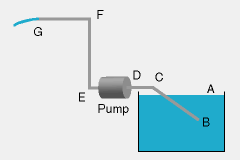| |
 |
Water is pumped through a system of pipes all of which have the same diameter. The water is taken from a tank at some depth, and it is transported and pumped to a point high above the water in the tank.
We have the following information regarding pressure. In a fluid, the pressure goes up if we go down. In a pump, the pressure goes up in the direction of flow. If there is friction as the result of flow through a pipe, the pressure goes down in the direction of flow. These effects can be combined.
-
Generally, there is a pressure difference for every element between two points. Identify the types of processes taking place in each system. Standard processes in our system are: gravitational (going up or down in a fluid), friction in flow, pumps. Can there be more than one process between two points?
-
Sketch a pressure - position diagram for positions going from A – G. How can the path from A – G be made into a closed circuit?
-
What is the smallest pressure difference the pump has to set up? Why is the real value bigger?
|
 |
-
When the water flows, is the pressure difference from E to F smaller than, equal to, or larger than the pressure difference due to the height difference? Why?
-
The pressure difference from G to E is 13,000 Pa. Ambient pressure is 96,000 Pa, and the pressure at D is 94,000 Pa. How big is the pressure difference set up by the pump?
-
The pressure difference from G to E is 13,000 Pa. Ambient pressure is 96,000 Pa, and the pressure at D is 94,000 Pa. How big is the pressure difference set up by the pump?
 |


